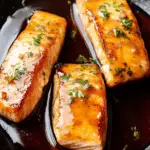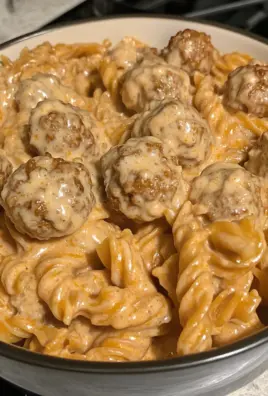Brown sugar glazed salmon is a savory-sweet seafood dish where pan-seared salmon fillets are coated in a rich, caramelized glaze. The glaze is a blend of brown sugar, soy sauce, lemon juice, ginger, and garlic, giving it a balanced, bold flavor profile. The high heat of the skillet creates a beautifully crisp surface, while the inside stays tender and flaky. The glaze thickens slightly to coat the salmon with a glossy finish that is both sweet and umami-rich.

This dish is a reliable 30-minute dinner, making it ideal for busy weeknights. It’s versatile, easy to prepare, and adaptable to a variety of sides like rice, roasted vegetables, or salad.
Why You’ll Love This Recipe
There are plenty of reasons why this brown sugar glazed salmon should be in your regular rotation:
- Fast and easy – ready in under 30 minutes
- Perfect balance of sweet and savory flavors
- Uses simple pantry staples
- Family-friendly and great for dinner parties
- Adaptable for gluten-free diets (just use tamari instead of soy sauce)
- Pairs well with many sides, making it easy to create a full meal
This recipe is ideal if you’re looking for something flavorful and fuss-free. The glaze elevates the dish without requiring any advanced culinary skills.
Preparation Phase and Tools to Use
Before cooking, preparation is key. Take 15–20 minutes to gather your tools and ingredients to streamline the process.
Essential Tools and Equipment
- Non-stick or cast iron skillet – essential for searing and caramelization
- Small mixing bowl – to combine the glaze ingredients
- Measuring spoons and cups – for accurate ratios
- Spatula or fish turner – to flip the salmon gently without tearing
- Microplane or zester – for finely grating the ginger
Importance of Each Tool
Using the right tools ensures even cooking and helps avoid common kitchen issues like sticking or overcooking. A high-quality skillet distributes heat evenly and helps the glaze develop its signature glossy texture. A microplane makes grating fresh ginger quick and efficient, allowing the aromatics to fully infuse into the glaze.
Preparation Tips
- Remove salmon from the refrigerator about 15–20 minutes before cooking to allow it to come to room temperature. This helps it cook more evenly.
- Pat the salmon dry with paper towels to ensure a good sear. Moisture prevents caramelization.
- Season the fillets with salt and pepper before searing.
- Pre-mix the glaze ingredients in a bowl so it’s ready to pour into the skillet once the salmon is nearly done.
- Use fresh ginger and lemon juice for the best flavor. Pre-packaged options won’t provide the same brightness or depth.
Ingredients
For the Salmon
- 1 pound fresh salmon, cut into 4 equal pieces
- Salt and pepper, to taste
- 1 tablespoon olive oil
- 2 tablespoons butter, divided
For the Sauce
- 3 tablespoons brown sugar
- 1 tablespoon soy sauce
- ¼ teaspoon garlic powder
- 1 tablespoon lemon juice
- ½ teaspoon freshly grated ginger
- 1 teaspoon Worcestershire sauce
- 2 tablespoons chicken broth or water
- 1 teaspoon cornstarch
Step-by-Step Directions
1. Prep the Salmon
- Bring the salmon to room temperature by removing it from the fridge 15–20 minutes before cooking.
- Pat the fillets dry with paper towels.
- Season both sides with salt and pepper.
2. Make the Glaze
- In a small bowl, whisk together brown sugar, soy sauce, garlic powder, lemon juice, ginger, Worcestershire sauce, chicken broth (or water), and cornstarch.
- Set aside until ready to use.
3. Sear the Salmon
- Heat a skillet over medium-high heat.
- Add olive oil and 1 tablespoon of butter.
- Once hot, place the salmon fillets skin-side down.
- Cook for about 5 minutes without moving them to allow the skin to crisp.
- Flip carefully and reduce the heat to medium.
- Cook for another 2–3 minutes or until nearly cooked through.
4. Glaze the Salmon
- Add the remaining tablespoon of butter to the skillet and let it melt.
- Pour the prepared glaze mixture into the skillet, distributing it around the salmon.
- Let the sauce bubble and thicken for 20–30 seconds.
- Flip the salmon once more and spoon the glaze over the top.
5. Serve
- Serve immediately with rice, vegetables, or a crisp salad.
- The skin is optional to eat but offers a satisfying crunch if kept on.
Serving Suggestions
Brown sugar glazed salmon is a versatile main dish that works well with a wide range of sides. The sweet-savory glaze makes it an ideal pairing with foods that balance richness, add texture, or contribute freshness. Whether you’re preparing a weeknight meal or hosting a dinner party, you can round out the plate in several ways.
Best Ways to Serve It
- Over rice – A neutral starch like jasmine or basmati rice soaks up the glaze beautifully and makes the dish more filling.
- With roasted vegetables – Try roasted broccoli, Brussels sprouts, or carrots for a caramelized, earthy contrast.
- On a salad – Place a warm salmon fillet over mixed greens with a light vinaigrette for a fresh and satisfying meal.
- With noodles – Rice noodles or soba tossed in a light sesame dressing offer an Asian-inspired side that complements the glaze.
- In lettuce wraps – Flake the salmon and wrap it in butter lettuce with shredded veggies and herbs for a light and modern option.
Side Dish Recommendations
Here are eight delicious side dishes that pair especially well with brown sugar glazed salmon. They help balance the sweetness of the glaze while adding depth and variety to your meal.
1. Steamed Jasmine Rice
Simple, fluffy jasmine rice is the go-to base for soaking up the sauce and balancing the sweet-savory flavor of the glaze.
2. Roasted Asparagus
Asparagus adds a mild bitterness and firm texture that contrasts nicely with the tender salmon. Roast it with olive oil and a touch of lemon zest.
3. Garlic Mashed Potatoes
Creamy, buttery mashed potatoes bring comfort to the plate and provide a rich contrast to the glaze’s tangy elements.
4. Quinoa with Herbs
Quinoa is a high-protein grain with a nutty flavor. Toss it with chopped parsley, dill, and lemon juice for a bright and healthy option.
5. Honey Glazed Carrots
Carrots mirror the glaze’s sweetness while offering an earthy undertone. Roast or sauté with a touch of honey and thyme.
6. Cucumber Avocado Salad
This cool, refreshing salad cuts through the salmon’s richness. Use lime juice, a touch of olive oil, and fresh herbs to enhance the flavor.
7. Sautéed Green Beans
Cooked with garlic and finished with a splash of lemon, green beans are a quick and colorful side that adds crunch.
8. Lemon Couscous
Fluffy couscous with lemon juice, olive oil, and scallions complements the citrus notes in the glaze and adds a Mediterranean twist.
Common Mistakes to Avoid
Even though brown sugar glazed salmon is relatively easy to prepare, there are several key mistakes that can affect the outcome. Avoiding these ensures the texture, flavor, and visual appeal stay on point.
Overcooking the Salmon
This is the most common mistake. Salmon is best when it is just cooked through but still moist in the center. Overcooked salmon becomes dry and loses its delicate texture. Remove it from heat just before it’s fully cooked; it will continue to cook slightly as it rests.
Cooking with Cold Fillets
Putting cold salmon directly in the skillet can lead to uneven cooking. Always let it come to room temperature for 15 to 20 minutes before cooking. This ensures even searing and helps avoid undercooked centers.
Skipping the Pat-Dry Step
Moisture on the surface of the salmon prevents a proper sear. Blot the fillets thoroughly with paper towels before seasoning to encourage caramelization.
Not Pre-mixing the Glaze
The glaze thickens quickly in the pan, so it should be fully mixed beforehand. This allows you to add it at the right time without scrambling for ingredients mid-cook.
Using Too Much Sauce
Less is more when glazing salmon. A small amount of sauce goes a long way, especially once it reduces and concentrates. You can always spoon extra over the top after cooking.
Crowding the Skillet
Trying to sear multiple fillets at once in a small pan can lead to steaming instead of searing. If necessary, cook in batches to maintain a crisp texture.
Flipping Too Soon
Wait until the salmon easily releases from the pan before flipping. If it sticks, it’s not ready. Flipping too early can damage the fillet and ruin the crust.
How to Perfect the Recipe
Getting the most out of this dish comes down to preparation, timing, and small adjustments. Here are a few additional tips to ensure your brown sugar glazed salmon turns out perfectly each time:
- Use fresh salmon whenever possible for better flavor and texture.
- Don’t skip the butter; it adds richness and helps the glaze develop a silky finish.
- Adjust the glaze balance by adding more lemon for acidity or more brown sugar for sweetness, depending on preference.
- Taste the glaze before adding it to the skillet and tweak it as needed.
- Spoon the glaze over the salmon during the last moments of cooking to layer the flavor and improve the presentation.
Recipe Tips for Success
Making brown sugar glazed salmon is straightforward, but a few additional tips can take your results from good to exceptional. These suggestions help refine the texture, balance flavors, and simplify preparation.
Use Fresh Ingredients
Fresh ginger, lemon juice, and salmon yield the best results. Pre-packaged alternatives can dull the flavor, especially in a dish where the glaze is the star.
Freeze Ginger for Easy Grating
Keep fresh ginger in the freezer and grate it directly into the sauce using a microplane. It saves time and ensures even distribution in the glaze.
Taste the Glaze Before Cooking
The glaze can be easily adjusted to suit your taste. If you prefer it tangier, increase the lemon juice. For more sweetness, add an extra teaspoon of brown sugar. A touch of crushed red pepper flakes adds heat if desired.
Sear, Then Glaze
Always sear the salmon first to develop a crispy surface before adding the glaze. This keeps the fish from becoming soggy and allows the glaze to coat the salmon evenly once thickened.
Spoon the Glaze Over the Top
Once the glaze begins to bubble and reduce, spoon it over the salmon multiple times. This helps build flavor layers and gives the fish a glossy finish.
Storage and Reheating Instructions
Proper storage and reheating techniques keep brown sugar glazed salmon tasting great even after the initial meal. Follow these simple guidelines to maintain quality and texture.
How to Store
- Refrigerate any leftover salmon in an airtight container. It will stay fresh for up to 3 days.
- If you plan to keep it longer, store it in the freezer. Wrap the salmon in foil or plastic wrap, then place it in a freezer-safe bag. It can be frozen for up to 1 month.
How to Reheat
- In a skillet: Place salmon in a non-stick skillet over low heat. Cover and warm for 5 to 7 minutes. This method helps preserve the glaze.
- In the oven: Preheat oven to 275°F. Wrap the salmon loosely in foil and heat for 10 to 15 minutes.
- In the microwave: Use only for quick reheating. Place salmon on a microwave-safe plate and cover with a damp paper towel. Heat in 30-second intervals until warm.
Avoid reheating on high heat to prevent the salmon from drying out. Glaze can be refreshed by adding a splash of water or broth during reheating.
Frequently Asked Questions
What does brown sugar do for salmon?
Brown sugar helps create a caramelized crust when seared in a skillet. It balances the savory components of the glaze and adds depth to the overall flavor profile.
Can I make the glaze ahead of time?
Yes, the glaze can be mixed ahead and stored in the refrigerator for up to three days. Whisk again before using, especially if the cornstarch has settled.
Is this recipe gluten-free?
It can be made gluten-free by substituting tamari or a certified gluten-free soy sauce for traditional soy sauce.
Can I use frozen salmon?
Yes. Make sure to thaw it fully in the refrigerator and pat it completely dry before seasoning. Moisture left on the surface will prevent the salmon from searing properly.
What can I substitute for Worcestershire sauce?
If you don’t have Worcestershire sauce, use a combination of soy sauce and a splash of vinegar, or substitute with coconut aminos for a gluten- and soy-free option.
Can I bake this instead of pan-searing?
You can bake the salmon at 400°F for 12–15 minutes, then pour the glaze over it during the last few minutes of cooking. Broil for 1–2 minutes to caramelize the glaze on top.
Conclusion
Brown sugar glazed salmon is a dependable and flavorful dish that fits perfectly into any meal plan. Whether you’re cooking for yourself or preparing dinner for guests, it offers restaurant-quality flavor in under 30 minutes. The balance of sweetness from the brown sugar, saltiness from the soy sauce, and acidity from the lemon juice creates a glaze that enhances the natural richness of the salmon.
The recipe is flexible and allows for personalization, making it easy to adapt to dietary preferences or available ingredients. Pair it with a fresh salad, hearty grains, or roasted vegetables, and you have a satisfying and nutritious meal ready to serve.
With the right preparation and attention to detail, this dish is sure to become a staple in your kitchen. For anyone looking to add a flavorful and elegant seafood dish to their repertoire, brown sugar glazed salmon delivers on all fronts.
Brown Sugar Glazed Salmon
Ingredients
For the Salmon:
- 1 pound fresh salmon cut into 4 equal pieces
- Salt and pepper to taste
- 1 tablespoon olive oil
- 2 tablespoons butter divided
For the Sauce:
- 3 tablespoons brown sugar
- 1 tablespoon soy sauce
- 1/4 teaspoon garlic powder
- 1 tablespoon lemon juice
- 1/2 teaspoon fresh ginger grated
- 1 teaspoon Worcestershire sauce
- 2 tablespoons chicken broth or water
- 1 teaspoon cornstarch
Instructions
Prep the Salmon
- Remove the salmon from the refrigerator 15–20 minutes before cooking to bring it to room temperature.
- Pat dry with paper towels and season both sides with salt and pepper.
Make the Sauce
- In a small bowl, whisk together the brown sugar, soy sauce, garlic powder, lemon juice, ginger, Worcestershire sauce, chicken broth (or water), and cornstarch. Set aside.
Sear the Salmon
- Once hot, place the salmon skin-side down and sear for about 5 minutes.
- Reduce the heat to medium, flip the salmon, and cook for another 2–3 minutes or until nearly cooked through.
Glaze the Salmon
- Add the remaining tablespoon of butter to the skillet and let it melt.
- Pour the prepared sauce into the skillet between the salmon pieces.
- Let the sauce bubble and thicken for 20–30 seconds, then remove the skillet from heat.
- Flip the salmon one more time and spoon the thickened glaze over the top.
Serve
- Serve immediately with your favorite sides such as rice, roasted vegetables, or a fresh salad.
- The skin will be crispy and flavorful, but it can be removed if preferred.




Leave a Comment